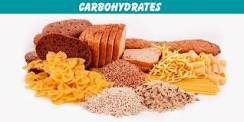CARBOHYDRATES IN THE BODY
A carbohydrate (/ kɑːrboʊhaʊdreɪt /) is a biomolecule composed of carbon (C), hydrogen (H) and oxygen (O) atoms, usually with a ratio of hydrogen to oxygen atoms of 2: 1 (as in in the water). and therefore with the empirical formula Cm (H 2 O) n (where m can be different from n). This formula applies to monosaccharides. There are some exceptions. For example, deoxyribose, a sugar component of DNA, has the molecular formula C5H10O4. Carbohydrates are technically carbohydrates. Structurally, it is more correct to consider them as aldoses and ketoses.
The term is most commonly used in biochemistry where it is synonymous with saccharide, a group comprising sugar, starch and cellulose. Saccharides are divided into four chemical groups: monosaccharides, disaccharides, oligosaccharides and polysaccharides. Monosaccharides and disaccharides, the smallest carbohydrates (of lower molecular weight), are commonly called sugars. The word saccharide comes from the Greek σάκχαρον (sákkharon) and means "sugar". Although the scientific nomenclature of carbohydrates is complex, the names of monosaccharides and disaccharides very often end in -osa, as in monosaccharides fructose (fructose) and glucose (starch sugar). and disaccharides sucrose (sugar cane or beet) and lactose (milk sugar).

Carbohydrates play many roles in living organisms. Polysaccharides are used to store energy (eg starch and glycogen) and as structural components (for example, cellulose in plants and chitin in arthropods). 5-carbon monosaccharide ribose is an important component of coenzymes (eg, ATP, FAD, and NAD) and the backbone of the genetic molecule called RNA. Associated deoxyribose is a component of DNA. Saccharides and their derivatives include many other important biomolecules for the immune system, fertilization, prevention of pathogenesis, blood clotting and development.
They are contained in a variety of natural and processed foods. Starch is a polysaccharide. It is rich in cereals (wheat, corn, rice), potatoes and processed cereal-based foods such as bread, pizza or pasta. Sugar is found in human nutrition mainly in the form of table sugar (sucrose, derived from sugar cane or sugar beet), lactose (rich in milk), glucose and fructose naturally present in the diet. honey, many fruits and some vegetables. Table sugar, milk or honey are often added to beverages and many prepared foods such as jams, cookies and cakes.
Cellulose, a polysaccharide present in the cell walls of all plants, is one of the major constituents of insoluble fiber. Insoluble fiber, though not digestible, helps maintain a healthy digestive system by relieving defecation. Other polysaccharides in fiber include resistant starch and inulin, which introduce certain bacteria into the microbiota of the large intestine and are metabolized by these bacteria to short-chain fatty acids.

Congratulations @superginee! You received a personal award!
You can view your badges on your Steem Board and compare to others on the Steem Ranking
Vote for @Steemitboard as a witness to get one more award and increased upvotes!